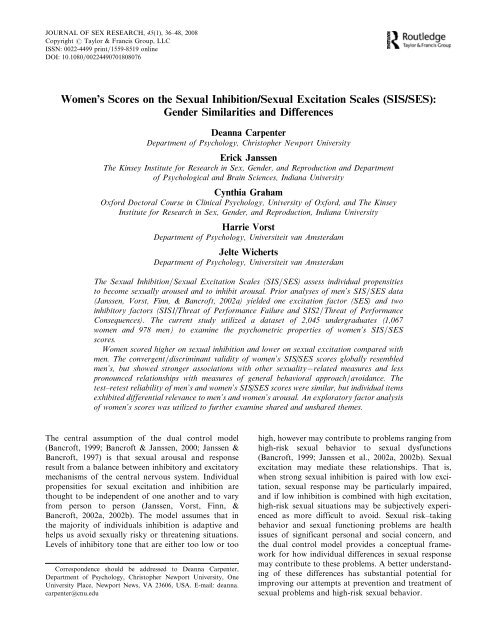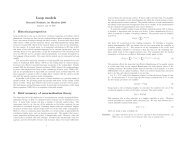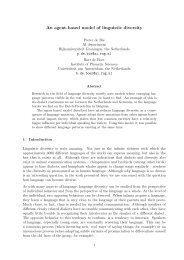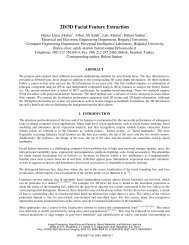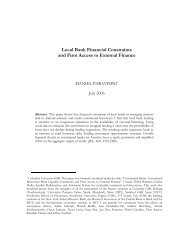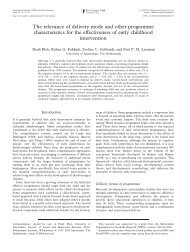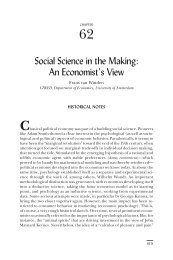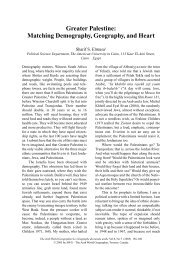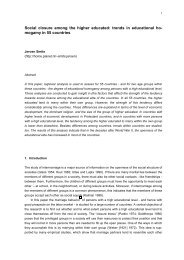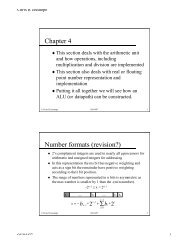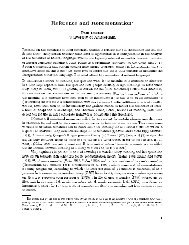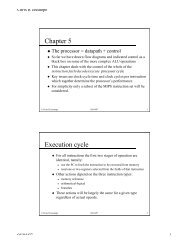Women's Scores on the Sexual Inhibition/Sexual Excitation Scales ...
Women's Scores on the Sexual Inhibition/Sexual Excitation Scales ...
Women's Scores on the Sexual Inhibition/Sexual Excitation Scales ...
You also want an ePaper? Increase the reach of your titles
YUMPU automatically turns print PDFs into web optimized ePapers that Google loves.
JOURNAL OF SEX RESEARCH, 45(1), 36–48, 2008<br />
Copyright # Taylor & Francis Group, LLC<br />
ISSN: 0022-4499 print=1559-8519 <strong>on</strong>line<br />
DOI: 10.1080/00224490701808076<br />
Women’s <str<strong>on</strong>g>Scores</str<strong>on</strong>g> <strong>on</strong> <strong>the</strong> <strong>Sexual</strong> Inhibiti<strong>on</strong>/<strong>Sexual</strong> Excitati<strong>on</strong> <strong>Scales</strong> (SIS/SES):<br />
Gender Similarities and Differences<br />
Deanna Carpenter<br />
Department of Psychology, Christopher Newport University<br />
Erick Janssen<br />
The Kinsey Institute for Research in Sex, Gender, and Reproducti<strong>on</strong> and Department<br />
of Psychological and Brain Sciences, Indiana University<br />
Cynthia Graham<br />
Oxford Doctoral Course in Clinical Psychology, University of Oxford, and The Kinsey<br />
Institute for Research in Sex, Gender, and Reproducti<strong>on</strong>, Indiana University<br />
Harrie Vorst<br />
Department of Psychology, Universiteit van Amsterdam<br />
Jelte Wicherts<br />
Department of Psychology, Universiteit van Amsterdam<br />
The <strong>Sexual</strong> Inhibiti<strong>on</strong>/<strong>Sexual</strong> Excitati<strong>on</strong> <strong>Scales</strong> (SIS/SES) assess individual propensities<br />
to become sexually aroused and to inhibit arousal. Prior analyses of men’s SIS/SES data<br />
(Janssen, Vorst, Finn, & Bancroft, 2002a) yielded <strong>on</strong>e excitati<strong>on</strong> factor (SES) and two<br />
inhibitory factors (SIS1/Threat of Performance Failure and SIS2/Threat of Performance<br />
C<strong>on</strong>sequences). The current study utilized a dataset of 2,045 undergraduates (1,067<br />
women and 978 men) to examine <strong>the</strong> psychometric properties of women’s SIS/SES<br />
scores.<br />
Women scored higher <strong>on</strong> sexual inhibiti<strong>on</strong> and lower <strong>on</strong> sexual excitati<strong>on</strong> compared with<br />
men. The c<strong>on</strong>vergent/discriminant validity of women’s SIS/SES scores globally resembled<br />
men’s, but showed str<strong>on</strong>ger associati<strong>on</strong>s with o<strong>the</strong>r sexuality related measures and less<br />
pr<strong>on</strong>ounced relati<strong>on</strong>ships with measures of general behavioral approach/avoidance. The<br />
test–retest reliability of men’s and women’s SIS/SES scores were similar, but individual items<br />
exhibited differential relevance to men’s and women’s arousal. An exploratory factor analysis<br />
of women’s scores was utilized to fur<strong>the</strong>r examine shared and unshared <strong>the</strong>mes.<br />
The central assumpti<strong>on</strong> of <strong>the</strong> dual c<strong>on</strong>trol model<br />
(Bancroft, 1999; Bancroft & Janssen, 2000; Janssen &<br />
Bancroft, 1997) is that sexual arousal and resp<strong>on</strong>se<br />
result from a balance between inhibitory and excitatory<br />
mechanisms of <strong>the</strong> central nervous system. Individual<br />
propensities for sexual excitati<strong>on</strong> and inhibiti<strong>on</strong> are<br />
thought to be independent of <strong>on</strong>e ano<strong>the</strong>r and to vary<br />
from pers<strong>on</strong> to pers<strong>on</strong> (Janssen, Vorst, Finn, &<br />
Bancroft, 2002a, 2002b). The model assumes that in<br />
<strong>the</strong> majority of individuals inhibiti<strong>on</strong> is adaptive and<br />
helps us avoid sexually risky or threatening situati<strong>on</strong>s.<br />
Levels of inhibitory t<strong>on</strong>e that are ei<strong>the</strong>r too low or too<br />
Corresp<strong>on</strong>dence should be addressed to Deanna Carpenter,<br />
Department of Psychology, Christopher Newport University, One<br />
University Place, Newport News, VA 23606, USA. E-mail: deanna.<br />
carpenter@cnu.edu<br />
high, however may c<strong>on</strong>tribute to problems ranging from<br />
high-risk sexual behavior to sexual dysfuncti<strong>on</strong>s<br />
(Bancroft, 1999; Janssen et al., 2002a, 2002b). <strong>Sexual</strong><br />
excitati<strong>on</strong> may mediate <strong>the</strong>se relati<strong>on</strong>ships. That is,<br />
when str<strong>on</strong>g sexual inhibiti<strong>on</strong> is paired with low excitati<strong>on</strong>,<br />
sexual resp<strong>on</strong>se may be particularly impaired,<br />
and if low inhibiti<strong>on</strong> is combined with high excitati<strong>on</strong>,<br />
high-risk sexual situati<strong>on</strong>s may be subjectively experienced<br />
as more difficult to avoid. <strong>Sexual</strong> risk–taking<br />
behavior and sexual functi<strong>on</strong>ing problems are health<br />
issues of significant pers<strong>on</strong>al and social c<strong>on</strong>cern, and<br />
<strong>the</strong> dual c<strong>on</strong>trol model provides a c<strong>on</strong>ceptual framework<br />
for how individual differences in sexual resp<strong>on</strong>se<br />
may c<strong>on</strong>tribute to <strong>the</strong>se problems. A better understanding<br />
of <strong>the</strong>se differences has substantial potential for<br />
improving our attempts at preventi<strong>on</strong> and treatment of<br />
sexual problems and high-risk sexual behavior.
WOMEN’S SIS=SES SCORES<br />
Janssen and colleagues (2002a) designed <strong>the</strong> to assess<br />
<strong>the</strong> tendency to resp<strong>on</strong>d sexually to a variety of erotic<br />
stimuli. The items <strong>on</strong> this measure c<strong>on</strong>sist primarily of<br />
‘‘if ...<strong>the</strong>n’’ statements (i.e., ‘‘If I am <strong>on</strong> my own watching<br />
a sexual scene in a film, I quickly become sexually<br />
aroused’’). Exploratory factor analysis of data provided<br />
by 408 male university undergraduates unexpectedly<br />
yielded three factors ra<strong>the</strong>r than two: <strong>on</strong>e related to sexual<br />
excitati<strong>on</strong> and two associated with sexual inhibiti<strong>on</strong><br />
(Janssen et al., 2002a). The excitati<strong>on</strong> factor (SES)<br />
describes sexual arousal stemming from social interacti<strong>on</strong>s,<br />
visual stimuli, fantasies, and n<strong>on</strong>sexual situati<strong>on</strong>s<br />
(such as bathing or lying in <strong>the</strong> sun). SIS1 focuses <strong>on</strong><br />
sexual inhibiti<strong>on</strong> due to threat of performance failure<br />
(e.g., difficulty getting aroused, losing arousal easily,<br />
c<strong>on</strong>cern about pleasing a partner, etc.). SIS2 assesses<br />
sexual inhibiti<strong>on</strong> due to potential c<strong>on</strong>sequences of sex<br />
(such as <strong>the</strong> risk of being caught=intruded up<strong>on</strong>, sexually<br />
transmitted diseases [STDs], unwanted pregnancy,<br />
and pain) (Janssen et al., 2002a). The three-factor structure<br />
was c<strong>on</strong>firmed in a sample of 459 undergraduate<br />
men, as well as a university-based sample of 313 male<br />
faculty and staff (Janssen et al., 2002a). Intercorrelati<strong>on</strong>s<br />
indicated that <strong>the</strong> excitati<strong>on</strong> factor (SES) and <strong>the</strong><br />
two inhibiti<strong>on</strong> factors (SIS1 and SIS2) were relatively<br />
independent (Janssen et al., 2002a, 2002b). SIS1 and<br />
SIS2 were related but not highly correlated (r ¼þ.26),<br />
suggesting that <strong>the</strong>y do not measure substantially overlapping<br />
c<strong>on</strong>structs.<br />
Results also suggested that SIS=SES scores showed<br />
acceptable test–retest reliability (r ¼þ.67 and þ.76 for<br />
<strong>the</strong> two samples) and good c<strong>on</strong>vergent=discriminant validity<br />
(Janssen et al., 2002a, 2002b). SES scores were modestly<br />
positively associated with scores <strong>on</strong> <strong>the</strong> Behavioral<br />
Inhibiti<strong>on</strong>=Behavioral Activati<strong>on</strong> <strong>Scales</strong> (BIS=BAS;<br />
Carver & White, 1994), <strong>the</strong> Neuroticism subscale of <strong>the</strong><br />
Eysenck Pers<strong>on</strong>ality Questi<strong>on</strong>naire (EPQ; Eysenck &<br />
Eysenck, 1975), and <strong>the</strong> Sociosexual Orientati<strong>on</strong> Inventory<br />
(SOI; Simps<strong>on</strong> & Gangestad, 1991), and more<br />
str<strong>on</strong>gly related to <strong>Sexual</strong> Opini<strong>on</strong> Survey (SOS) scores<br />
(Fisher, Byrne, White, & Kelley, 1988). See <strong>the</strong> Method<br />
secti<strong>on</strong> for a more detailed descripti<strong>on</strong> of <strong>the</strong>se measures.<br />
<str<strong>on</strong>g>Scores</str<strong>on</strong>g> <strong>on</strong> SIS1 and SIS2 showed some overlap: both<br />
were modestly positively associated with scores <strong>on</strong> <strong>the</strong><br />
Harm Avoidance Scale (MPQ-H). Only SIS2 scores,<br />
however, showed moderate negative correlati<strong>on</strong>s with<br />
SOS and SOI scores, and moderate positive relati<strong>on</strong>ships<br />
with scores <strong>on</strong> <strong>the</strong> Social Desirability Scale and <strong>the</strong><br />
BIS=BAS Behavioral Inhibiti<strong>on</strong> subscale.<br />
There are a number of reas<strong>on</strong>s to expect women and<br />
men to show different propensities for sexual inhibiti<strong>on</strong><br />
and excitati<strong>on</strong>. Bjorklund and Kipp (1996) suggest that<br />
gender differences in parental investment may have<br />
rendered sexual inhibiti<strong>on</strong> of particular importance to<br />
our female ancestors. Because reproducti<strong>on</strong> is associated<br />
with greater biological costs for females than for males<br />
(e.g., pregnancy), females especially would benefit from<br />
any mechanism that aids in c<strong>on</strong>trolling sexual desire and<br />
arousal (Wallen, 1995) and avoiding casual or opportunistic<br />
sex (Bjorklund & Kipp, 1996; Sym<strong>on</strong>s, 1979).<br />
In c<strong>on</strong>trast, our male ancestors may have benefited from<br />
higher levels of sexual excitati<strong>on</strong>. As <strong>the</strong> cost associated<br />
with fertilizati<strong>on</strong> is low, males may have increased<br />
reproductive potential by engaging in relatively indiscriminate,<br />
short-term mating with multiple partners<br />
(Buss, 1998; Knoth, Boyd, & Singer, 1988).<br />
Many reports of sexuality-related gender differences<br />
appear relevant to dual c<strong>on</strong>trol model processes.<br />
Research has found that males report earlier and more<br />
intense sexual arousal than females (Knoth, Boyd, &<br />
Singer, 1988), more frequent sexual desire (Beck,<br />
Bozman, & Qualtrough, 1991), and earlier, more<br />
frequent, and more varied sexual fantasies (Leitenberg<br />
& Henning, 1995). Men also spend more m<strong>on</strong>ey than<br />
women <strong>on</strong> sex, sexual products, and sexual entertainment<br />
(Baumeister, Catanese, & Vohs, 2001; Wallen,<br />
1995). In c<strong>on</strong>trast, women report less permissive attitudes<br />
regarding casual, premarital, and extramarital<br />
sex in comparis<strong>on</strong> with men (Clark & Hatfield, 1989;<br />
Cohen & Shotland, 1996; Oliver Hyde, 1993; Wuethrich,<br />
1993), as well as fewer desired (Buss & Schmitt, 1993)<br />
and actual lifetime sexual partners (Kinsey, Pomeroy,<br />
Martin, & Gebhard, 1953; Laumann, Gagn<strong>on</strong>, Michael,<br />
& Michaels, 1994; Wiederman, 1997). In a recent review,<br />
Baumeister and colleagues (2001) c<strong>on</strong>cluded that <strong>the</strong><br />
evidence for str<strong>on</strong>ger sex drive in men than women is ‘‘extensive,<br />
methodologically diverse, and c<strong>on</strong>sistent (p. 263).’’<br />
<strong>Sexual</strong> interest and expressi<strong>on</strong> clearly also are resp<strong>on</strong>sive<br />
to social influences (Hogben & Byrne, 1998). <strong>Sexual</strong><br />
attitudes and behaviors are related to a number of sociocultural<br />
factors, including educati<strong>on</strong>, religious affiliati<strong>on</strong><br />
and activity, marital status, and socioec<strong>on</strong>omic status<br />
(Kinsey, Pomeroy, & Martin, 1948; Laumann et al.,<br />
1994). More social c<strong>on</strong>trol of sexuality may be directed<br />
toward women than toward men (Crawford & Popp,<br />
2003), however, resulting in a sexual double standard.<br />
Female undergraduates report significantly more guilt<br />
associated with first intercourse than do males (Sprecher<br />
& Barbee, 1995), and female virgins report more positive<br />
and fewer negative emoti<strong>on</strong>s associated with <strong>the</strong>ir<br />
virginity than do males (Sprecher & Regan, 1996). In<br />
summary, <strong>the</strong> origins of gender differences in sexual<br />
behavior appear multifaceted, and <strong>the</strong> potential c<strong>on</strong>tributi<strong>on</strong>s<br />
of social c<strong>on</strong>structi<strong>on</strong> and biological factors<br />
deserve shared c<strong>on</strong>siderati<strong>on</strong> when interpreting data<br />
<strong>on</strong> sexual interest, behavior, and resp<strong>on</strong>se.<br />
Given extensive evidence for sexuality-related gender<br />
differences, Graham, Sanders, Milhausen, and McBride<br />
(2004) questi<strong>on</strong>ed whe<strong>the</strong>r <strong>the</strong> SIS=SES would be<br />
equally suited for use with women. Their specific c<strong>on</strong>cerns<br />
included <strong>the</strong> possibility that important influences<br />
<strong>on</strong> women’s arousal (such as reputati<strong>on</strong>, body image,<br />
37
CARPENTER, JANSSEN, GRAHAM, VORST, AND WICHERTS<br />
fear of pregnancy, and relati<strong>on</strong>ship=partner factors)<br />
might be underrepresented <strong>on</strong> <strong>the</strong> SIS=SES. To address<br />
this c<strong>on</strong>cern, Graham and colleagues (2004) used focus<br />
groups to explore women’s qualitative descripti<strong>on</strong>s of<br />
factors that influence <strong>the</strong>ir sexual arousal. Participants<br />
described <strong>the</strong>ir arousal as str<strong>on</strong>gly influenced by physical<br />
and emoti<strong>on</strong>al state (e.g., mood, horm<strong>on</strong>al changes, and<br />
stress levels), partner variables (e.g., pers<strong>on</strong>ality and<br />
attractiveness), relati<strong>on</strong>ship variables (e.g., issues related<br />
to physical and emoti<strong>on</strong>al safety, feeling desired), various<br />
aspects of <strong>the</strong> sexual interacti<strong>on</strong> (e.g., setting, timing,<br />
and partner’s skill and enthusiasm), and also culturally<br />
mediated c<strong>on</strong>cerns (e.g., religious influences and<br />
c<strong>on</strong>cerns about reputati<strong>on</strong>). As many of <strong>the</strong>se factors<br />
are not assessed by <strong>the</strong> SIS=SES in its current format,<br />
Graham, Sanders and Milhausen (2006) developed <strong>the</strong><br />
sexual Excitati<strong>on</strong>=<strong>Sexual</strong> Inhibiti<strong>on</strong> Inventory for<br />
Women (SESII-W). Exploratory factor analysis yielded<br />
eight factors and two higher-order factors (<strong>on</strong>e related<br />
to sexual excitati<strong>on</strong> and <strong>on</strong>e related to sexual inhibiti<strong>on</strong>).<br />
Using <strong>the</strong> SESII-W with a sample of male and female<br />
college students, Milhausen (2004) found significant<br />
gender differences, with men scoring higher <strong>on</strong> sexual<br />
excitati<strong>on</strong> and women <strong>on</strong> sexual inhibiti<strong>on</strong>.<br />
This study adopted a different approach to studying<br />
arousal processes in women. While <strong>the</strong> SIS=SES initially<br />
was validated in men, its development was based up<strong>on</strong><br />
an assumpti<strong>on</strong> that <strong>the</strong> neurobiological mechanisms<br />
underlying sexual inhibiti<strong>on</strong> and excitati<strong>on</strong> in women<br />
and men are shared. Our perspective is that even when<br />
gender differences are substantial, more variability will<br />
be observed within groups (e.g., individual differences)<br />
than between <strong>the</strong>m (women versus men). We also expect<br />
that <strong>the</strong> majority of potential influences <strong>on</strong> sexual arousal<br />
(such as <strong>the</strong> risk of STDs, sexual fantasy, distracti<strong>on</strong>,<br />
difficulties becoming aroused, etc.) are of substantial<br />
relevance to both women and men. Accordingly, we<br />
decided to examine women’s scores <strong>on</strong> <strong>the</strong> SIS=SES<br />
and attempt to c<strong>on</strong>firm <strong>the</strong> three-factor structure<br />
previously explored and validated in men.<br />
Hyde (2005) reviewed findings related to <strong>the</strong> gender<br />
similarities hypo<strong>the</strong>sis, which holds that men and<br />
women are more alike than different. Her results suggest<br />
that most reported effect sizes of psychological gender<br />
differences are small or close to zero (e.g., d < 0.35),<br />
but in citing notable excepti<strong>on</strong>s, she stated that gender<br />
differences <strong>on</strong> some sexuality-related variables (including<br />
incidence of masturbati<strong>on</strong> and attitudes about<br />
casual sex) are c<strong>on</strong>sistently large. Hyde (2005) discussed<br />
a number of social and interpers<strong>on</strong>al c<strong>on</strong>sequences of<br />
our tendency to focus <strong>on</strong> gender differences, and she<br />
suggested that such findings be reported and interpreted<br />
within <strong>the</strong> c<strong>on</strong>text of similarities between women and<br />
men. By approaching women’s data using a model<br />
explored in men, we hoped to highlight both shared<br />
and unshared influences <strong>on</strong> men’s and women’s sexual<br />
arousal.<br />
Hypo<strong>the</strong>sis 1. We expected to find evidence for a<br />
globally similar factor structure for men and women, as<br />
indicated by C<strong>on</strong>firmatory Factor Analysis (CFA) fit<br />
indices. We anticipated that <strong>the</strong> three-factor model might<br />
account for women’s scores slightly less well than men’s<br />
(perhaps due to missing <strong>the</strong>mes, as discussed by Graham<br />
and colleagues, 2004, 2006). We assumed, however, that<br />
decreased model-data fit might not necessarily imply that<br />
a three-factor model of women’s arousal is incorrect. We<br />
planned to interpret gender differences holistically,<br />
within <strong>the</strong> c<strong>on</strong>text of evidence for similarities.<br />
Hypo<strong>the</strong>sis 2. Published reports of gender<br />
differences in sexual interest, attitudes, and behavior<br />
led us to predict that women would score higher <strong>on</strong><br />
sexual inhibiti<strong>on</strong> and lower <strong>on</strong> sexual excitati<strong>on</strong> than<br />
would men.<br />
Hypo<strong>the</strong>sis 3. We expected to find gender<br />
similarities regarding test–retest reliability, internal<br />
validity, and c<strong>on</strong>vergent=discriminant validity of men’s<br />
and women’s SIS=SES scores.<br />
Hypo<strong>the</strong>sis 4. Finally, we expected some SIS=SES<br />
<strong>the</strong>mes (such as <strong>the</strong> risk of pregnancy or pain) to<br />
exhibit differential relevance to men’s and women’s<br />
arousal, but we did not make any specific item-level<br />
predicti<strong>on</strong>s regarding this assumpti<strong>on</strong>.<br />
Method<br />
Participants<br />
This study analyzed an<strong>on</strong>ymous data provided by<br />
2,045 Indiana University undergraduate students<br />
(1,067 females and 978 males) ranging in age from<br />
18 to 44, with a mean age of 19.8 years. Table 1<br />
describes participants’ characteristics. The sample<br />
included 1,067 women (mean age ¼ 19.4, SD ¼ 1.73,<br />
range ¼ 18–39) and 978 men (mean age ¼ 20.3,<br />
SD ¼ 2.35, range ¼ 18–44). Subjects were recruited<br />
from undergraduate psychology classes and received<br />
course credit for <strong>the</strong>ir participati<strong>on</strong>. The protocol for<br />
this study was reviewed and approved by <strong>the</strong> Instituti<strong>on</strong>al<br />
Review Board. Porti<strong>on</strong>s of <strong>the</strong> men’s data<br />
(N ¼ 537) previously have been reported by Janssen<br />
and colleagues (2002a) and are included in <strong>the</strong> analyses<br />
reported here for comparis<strong>on</strong> purposes.<br />
Measures<br />
Background questi<strong>on</strong>naire. This 35-item questi<strong>on</strong>naire<br />
collects self-report data <strong>on</strong> basic demographics<br />
and sexuality-related variables (including number of sexual<br />
partners, use of c<strong>on</strong>traceptives, number of HIV tests,<br />
38
WOMEN’S SIS=SES SCORES<br />
Table 1.<br />
Subject Demographics<br />
N (%)<br />
Men Women Total (%)<br />
Ethnicity (N ¼ 2,002) Asian 37 (3.8) 32 (3.1) 69 (3.5)<br />
African American 31 (3.2) 48 (4.7) 79 (4.0)<br />
Hispanic 19 (2.0) 23 (2.2) 42 (2.1)<br />
White 861 (88.4) 894 (86.9) 1,755 (87.7)<br />
O<strong>the</strong>r 25 (2.6) 32 (3.1) 57 (2.9)<br />
Orientati<strong>on</strong> a (N ¼ 2,008) Hetero=straight 912 (94.3) 1,008 (96.8) 1,920 (95.6)<br />
Homosexual=gay 24 (2.5) 5 (
CARPENTER, JANSSEN, GRAHAM, VORST, AND WICHERTS<br />
tendency to have predominantly positive or negative<br />
emoti<strong>on</strong>al and evaluative resp<strong>on</strong>ses to sexual stimuli<br />
(Fisher et al., 1988).<br />
The sociosexual orientati<strong>on</strong> inventory (SOI). This<br />
questi<strong>on</strong>naire c<strong>on</strong>sists of eight items that assess<br />
attitudes toward and participati<strong>on</strong> in ‘‘casual’’ sex, as<br />
well as self-reported c<strong>on</strong>dom use during sexual<br />
encounters (Simps<strong>on</strong> & Gangestad, 1991).<br />
Procedure<br />
Same-sex research assistants c<strong>on</strong>ducted single-sex<br />
group testing sessi<strong>on</strong>s lasting up to <strong>on</strong>e hour. Participants<br />
completed <strong>on</strong>e of three testing packets, depending<br />
<strong>on</strong> time of recruitment. One hundred eighty-two<br />
women completed a test packet c<strong>on</strong>sisting of <strong>the</strong> Background<br />
Questi<strong>on</strong>naire, 77-item SIS=SES, and SDSR-5.<br />
Ano<strong>the</strong>r 741 women and 441 men completed <strong>the</strong><br />
Background Questi<strong>on</strong>naire and 45-item SIS=SES. Finally,<br />
144 women and 537 men completed <strong>the</strong> Background<br />
Questi<strong>on</strong>naire, SOS, SOI, EPQ, MPQ-H, SDSR-5,<br />
BIS=BAS, and 77-item SIS=SES.<br />
Data Analysis<br />
Data regarding <strong>the</strong> general demographics, relati<strong>on</strong>ship<br />
status, attitudes, sexual interest, behavior, and<br />
sexual functi<strong>on</strong>ing of male (N ¼ 978) and female participants<br />
(N ¼ 1,067) were summarized and compared<br />
using Mann–Whitney, chi square (v 2 ), and t-test analyses.<br />
All statistical tests, with <strong>the</strong> excepti<strong>on</strong> of <strong>the</strong> CFAs,<br />
were c<strong>on</strong>ducted using SPSS 10.<br />
CFAs in LISREL 8.54 (Jöreskog & Sörbom, 1993)<br />
examined whe<strong>the</strong>r women’s SIS=SES scores are characterized<br />
by a factor structure similar to men’s, featuring<br />
<strong>on</strong>e sexual excitati<strong>on</strong> factor and two sexual inhibiti<strong>on</strong><br />
factors. Three models were compared in women<br />
(N ¼ 966) and men (N ¼ 922), including <strong>the</strong> three-factor<br />
45-item model, a 10-factor 45-item model, and a ‘‘10-in-<br />
3’’ hierarchical model featuring 45 item scores and 10<br />
subscales loading <strong>on</strong>to three higher-level factors. These<br />
models all derive from prior analyses of men’s SIS=SES<br />
SES data (Janssen et al., 2002a).<br />
Men’s and women’s mean scores <strong>on</strong> <strong>the</strong> higher- and<br />
lower-level ‘‘10-in-3’’ SIS=SES scales were calculated<br />
and compared using MANOVAs, and <strong>the</strong> internal c<strong>on</strong>sistency<br />
of <strong>the</strong> three higher-level scales were assessed via<br />
Cr<strong>on</strong>bach’s alpha coefficients. Because results of tests<br />
for strict factorial invariance (Meredith, 1993) indicated<br />
<strong>the</strong> presence of some item intercept differences across<br />
gender groups, LISREL modificati<strong>on</strong> indices were used<br />
to correct for uniform measurement bias, and effect sizes<br />
for gender differences were calculated by dividing factor<br />
mean differences by pooled within-group standard<br />
deviati<strong>on</strong>s of <strong>the</strong> factors. Correlati<strong>on</strong>s am<strong>on</strong>g <strong>the</strong> SES,<br />
SIS1, and SIS2 scales were examined via Holm’s<br />
sequential B<strong>on</strong>ferr<strong>on</strong>i procedure. The test–retest<br />
reliability and internal c<strong>on</strong>sistency of women’s SIS=SES<br />
SES scores (N ¼ 51) were analyzed using correlati<strong>on</strong><br />
coefficients and Cr<strong>on</strong>bach’s alpha. Correlati<strong>on</strong>s am<strong>on</strong>g<br />
<strong>the</strong> SES, SIS1, and SIS2 factors and women’s scores<br />
<strong>on</strong> <strong>the</strong> SDSR-5 (N ¼ 1,040), BIS=BAS, EPQ, MPQ-H,<br />
SOS, and SOI (N ¼ 141) were used to assess c<strong>on</strong>vergent<br />
and discriminant validity of <strong>the</strong> SIS=SES scales. Finally,<br />
because our CFAs suggested differential relevance of<br />
some <strong>the</strong>mes to men’s and women’s arousal, we used<br />
exploratory factor analysis (EFA) to examine whe<strong>the</strong>r<br />
different <strong>the</strong>mes would be involved in a three-factor<br />
model based <strong>on</strong> women’s data (N ¼ 307). Exploratory<br />
Factor Analysis (EFA) utilized principal axis factor<br />
extracti<strong>on</strong> with varimax rotati<strong>on</strong>.<br />
Results<br />
Sample characteristics. Most participants were<br />
young, White unmarried, heterosexual undergraduate<br />
students of modest sexual experience. Participants<br />
reported having had sexual intercourse with a mean of<br />
1.7 partners (SD ¼ 2.86, range ¼ 0–50, N ¼ 2,004) in<br />
<strong>the</strong> past year, and an average of 1.4 unprotected<br />
intercourse partners (SD ¼ 2.08, range ¼ 0–30,<br />
N ¼ 1,996) during <strong>the</strong> past 3 years. For additi<strong>on</strong>al<br />
demographics, see Table 1.<br />
Our male and female participants differed in several<br />
respects. Women were somewhat more likely than men<br />
to describe <strong>the</strong>ir orientati<strong>on</strong> as heterosexual and somewhat<br />
less likely to describe <strong>the</strong>mselves as homosexual<br />
(Table 1). More women (16.9%) than men (9.7%), however,<br />
reported feeling attracted to members of <strong>the</strong>ir own<br />
gender at least some of <strong>the</strong> time (Z ¼ 4.33, p .001).<br />
Men and women also differed regarding <strong>the</strong>ir relati<strong>on</strong>ship<br />
status: women were moderately more likely than<br />
men to report an <strong>on</strong>going m<strong>on</strong>ogamous relati<strong>on</strong>ship<br />
than men, and <strong>the</strong>y were somewhat less likely than<br />
men to report ei<strong>the</strong>r a n<strong>on</strong>exclusive relati<strong>on</strong>ship or no<br />
current relati<strong>on</strong>ship (Table 1). Female participants<br />
ascribed greater importance to religi<strong>on</strong> than males<br />
(Z ¼ 5.48, p .001), whereas men attributed greater<br />
importance to sex in comparis<strong>on</strong> with women<br />
(Z ¼ 11.63, p .001). Men were more likely than<br />
women to agree that ‘‘sex without love is okay’’<br />
(t (679) ¼ 4.56, p ¼ .001), and that <strong>the</strong>y could imagine<br />
<strong>the</strong>mselves enjoying ‘‘casual’’ sex with different partners<br />
(t (243.07) ¼ 8.53, p ¼ .001). Men also reported desiring<br />
more sexual partners (X ¼ 5:84, SD ¼ 10.26,<br />
range ¼ 0–125) during <strong>the</strong> next 5 years (t(672) ¼<br />
3.10, p ¼ .002) in comparis<strong>on</strong> with women (X ¼ 3:13,<br />
SD ¼ 4.04, range ¼ 0–40). Men reported more frequent<br />
masturbati<strong>on</strong> than women (Z ¼ –26.08, p .001), more<br />
intercourse partners (X ¼ 1:98 vs. 1.52) during <strong>the</strong><br />
previous year (t (1419.37) ¼ 3.61, p ¼ .001), and more<br />
<strong>on</strong>e-night stands (X ¼ 2:12 vs. 1.15) over <strong>the</strong> course of<br />
40
WOMEN’S SIS=SES SCORES<br />
Table 2. C<strong>on</strong>firmatory Factor Analysis Results for Women<br />
and Men<br />
Group=Model v 2 df CFI SRMR NNFI RMSEA<br />
Women (N ¼ 966)<br />
Ten factor 2841.7 900 0.91 0.058 0.91 0.050<br />
Ten in three 3218.8 932 0.90 0.067 0.89 0.055<br />
Three factor 4373.1 942 0.85 0.073 0.84 0.073<br />
Men (N ¼ 922)<br />
Ten factor 2385.1 900 0.94 0.055 0.93 0.044<br />
Ten in three 2605.2 932 0.93 0.062 0.93 0.047<br />
Three factor 3287.8 942 0.90 0.066 0.90 0.057<br />
Note: v 2 ¼ Model chi square; CFI ¼ Bentler comparative fit index;<br />
SRMR ¼ Standardized Root Mean Square Residual; NNFI ¼ Tucker-<br />
Lewis N<strong>on</strong>-normed Fit Index; RMSEA ¼ Steiger-Lind Root Mean<br />
Square Error of Approximati<strong>on</strong> Index. (Better fit is reflected in higher<br />
coefficients [values approaching 1.0] for CFI and NNFI, and in smaller<br />
values [lower bound of zero] for SRMR and RMSEA.)<br />
<strong>the</strong>ir lifetimes (t (1902.04) ¼ 3.78, p ¼ .001). Finally, in<br />
comparis<strong>on</strong> with men, female participants reported<br />
more frequent difficulties with sexual arousal in <strong>the</strong> past<br />
3 m<strong>on</strong>ths (Z ¼ 7.57, p .001) and less frequent<br />
orgasms during sexual activity with a partner in <strong>the</strong> past<br />
year (Z ¼ 11.24, p .001).<br />
C<strong>on</strong>firmatory factor analysis results for<br />
women. CFA was utilized to test whe<strong>the</strong>r <strong>the</strong><br />
previously established three-factor model of men’s<br />
SIS=SES scores (Janssen et al., 2002a) dem<strong>on</strong>strated<br />
acceptable fit to a female dataset. This factor soluti<strong>on</strong><br />
was compared with two alternative models previously<br />
examined in males. These included a simple 45-item,<br />
10-factor model, and a ‘‘10-in-3’’ hierarchical model,<br />
featuring <strong>the</strong> same 45-item scores and 10 subscales<br />
loading <strong>on</strong>to three higher-level factors. After cases<br />
were eliminated due to missing data, <strong>the</strong> resp<strong>on</strong>ses of<br />
966 women and 922 men were retained. These analyses<br />
(with comparis<strong>on</strong> statistics for men) are presented in<br />
Table 2.<br />
The v 2 test of <strong>the</strong> null hypo<strong>the</strong>sis (which assumes<br />
complete model data c<strong>on</strong>sistency) had to be rejected<br />
for all models for both women and men (Janssen et al.,<br />
2002a). This finding was not unexpected, given <strong>the</strong> number<br />
of observati<strong>on</strong>s and <strong>the</strong> complexity of <strong>the</strong> specified<br />
models. Moreover, <strong>the</strong> v 2 is inflated because of <strong>the</strong> use<br />
of n<strong>on</strong>normal data (i.e., Likert scale items). Therefore,<br />
we also utilized alternative fit measures that are less<br />
sensitive to sample size, or that do not depend solely<br />
<strong>on</strong> <strong>the</strong> v 2 statistic. The Standardized Root Mean Square<br />
Residual (SRMR) is a functi<strong>on</strong> of <strong>the</strong> residuals. Hu and<br />
Bentler (1999) proposed that values below .08 are<br />
indicative of good model fit.<br />
Bentler’s Comparative Fit Index (CFI) and <strong>the</strong><br />
Bentler–B<strong>on</strong>nett N<strong>on</strong>-normed Fit Index (NNFI) are<br />
popular fit measures that compare <strong>the</strong> existing model<br />
with <strong>the</strong> independence model. Hu and Bentler (1999)<br />
proposed that an NNFI and a CFI above .95 is<br />
preferred (range ¼ 0–1; higher values mean better fit),<br />
although models with values of NNFI and CFI >.90<br />
often are seen as good fitting models. Finally, <strong>the</strong> Steiger-Lind<br />
Root Mean Square Error of Approximati<strong>on</strong><br />
(RMSEA) index is relatively insensitive to sample size<br />
and corrects for model complexity. Smaller values (with<br />
a lower bound of zero) indicate better fit. In general, an<br />
RMSEA of
CARPENTER, JANSSEN, GRAHAM, VORST, AND WICHERTS<br />
Table 3.<br />
Stepwise Test for Factorial Invariance Over Sex<br />
Model Restricti<strong>on</strong> v 2 df CFI NNFI RMSEA<br />
Ten factor C<strong>on</strong>figurati<strong>on</strong> 5226.8 1800 0.93 0.92 0.047<br />
Factor loadings 5326.5 1835 0.93 0.92 0.047<br />
Residual 5608.8 1880 0.92 0.92 0.048<br />
variance<br />
Intercepts 7090.1 1915 0.89 0.89 0.058<br />
Ten in three C<strong>on</strong>figurati<strong>on</strong> 823.9 1864 0.92 0.91 0.052<br />
factor Factor loadings 5932.1 1899 0.91 0.91 0.051<br />
Residual 6203.4 1944 0.91 0.91 0.052<br />
variance<br />
Intercepts 7605.1 1979 0.88 0.88 0.060<br />
Three factor C<strong>on</strong>figurati<strong>on</strong> 7660.8 1884 0.88 0.87 0.066<br />
Factor loadings 7809.5 1926 0.87 0.87 0.065<br />
Residual 8153.6 1971 0.87 0.87 0.067<br />
variance<br />
Intercepts 9859.3 2013 0.83 0.84 0.074<br />
Note: v 2 ¼ Model chi square; CFI ¼ Bentler Comparative Fit Index;<br />
NNFI ¼ Bentler–B<strong>on</strong>nett N<strong>on</strong>-normed Fit Index; RMSEA ¼<br />
Steiger-Lind Root Mean Square Error of Approximati<strong>on</strong> Index.<br />
(Better fit is reflected in higher coefficients [values approaching 1.0]<br />
for <strong>the</strong> CFI and NNFI, and in smaller values [lower bound of zero]<br />
for v 2 =df ratios and RMSEA.)<br />
subscales (F(10, 2005) ¼ 120.44, p .001) indicated<br />
that <strong>the</strong> pattern of SIS=SES scale scores differed for<br />
male and female participants. ANOVAs revealed significant<br />
gender differences <strong>on</strong> <strong>the</strong> higher-level sexual excitati<strong>on</strong><br />
(SES) and inhibiti<strong>on</strong> scales (SIS1=Threat of<br />
Performance Failure and SIS2=Threat of C<strong>on</strong>sequences).<br />
As predicted, men’s SES scores were significantly<br />
higher than women’s (F (1, 2006) ¼ 230.19, p .001),<br />
while women scored higher than men <strong>on</strong> both SIS1<br />
(F (1, 2006) ¼ 138.41, p .001) and SIS2 (F(1, 2006) ¼<br />
425.13, p .001). Effect sizes for gender differences were<br />
as follows: SES (d ¼ .67), SIS1 (d ¼ .57), and SIS2<br />
(d ¼ .92). Distributi<strong>on</strong>s, means, standard deviati<strong>on</strong>s,<br />
and ranges of participants’ scores <strong>on</strong> <strong>the</strong> three higherlevel<br />
SIS=SES scales are presented in Table 4.<br />
Cr<strong>on</strong>bach’s alpha coefficients for <strong>the</strong> three higherlevel<br />
scales are also presented in Table 4. The internal<br />
c<strong>on</strong>sistency of <strong>the</strong> SES, SIS1, and SIS2 scales appears<br />
acceptable for both women and men (Janssen et al.,<br />
2002a).<br />
ANOVAs also revealed significant gender differences<br />
<strong>on</strong> 9 of <strong>the</strong> 10 lower-level SIS=SES subscales. Women<br />
had higher scores than men <strong>on</strong> <strong>the</strong> sexual inhibiti<strong>on</strong> subscales,<br />
while men had higher scores than women <strong>on</strong> all<br />
of <strong>the</strong> sexual excitati<strong>on</strong> subscales (Table 5). Because<br />
<strong>the</strong> factor analyses indicated <strong>the</strong> presence of uniform<br />
bias <strong>on</strong> some items, Table 5 also gives <strong>the</strong> results of<br />
<strong>the</strong> factor mean differences based <strong>on</strong> factor analyses of<br />
items after correcti<strong>on</strong> for bias. The bias-corrected and<br />
n<strong>on</strong>corrected results show str<strong>on</strong>g c<strong>on</strong>vergence, indicating<br />
that <strong>the</strong>se gender differences are not exclusively<br />
due to measurement bias. The ‘‘Performance C<strong>on</strong>cerns’’<br />
subscale is a potential excepti<strong>on</strong> warranting fur<strong>the</strong>r<br />
study, as bias correcti<strong>on</strong> reduced factor mean differences<br />
<strong>on</strong> this subscale.<br />
Relati<strong>on</strong>ships between <strong>the</strong> SIS=SES<br />
<strong>Scales</strong>. Women’s scores (N ¼ 1,040) <strong>on</strong> <strong>the</strong> three<br />
higher-level scales (SES, SIS1, and SIS2) suggested<br />
that relati<strong>on</strong>ships between SES and <strong>the</strong> two sexual<br />
inhibiti<strong>on</strong> scales (SIS1, and SIS2) for women were<br />
negligible (r ¼þ.05 and .07, respectively) and<br />
similar to men’s (r ¼ .05 and .09 in Janssen<br />
and colleagues’ (2002a) sample of 408 men). The SIS1<br />
and SIS2 scales were associated modestly in women<br />
(r ¼þ.19). This difference was slightly more<br />
pr<strong>on</strong>ounced in men (r ¼þ.27; Janssen et al., 2002a),<br />
and reflects a significant gender difference (z ¼ 1.88).<br />
These statistics indicate that <strong>the</strong> three higher-level<br />
SIS=SES scales are relatively independent in both<br />
women and men.<br />
Table 4.<br />
Gender Comparis<strong>on</strong>s SES, SIS1, and SIS2<br />
SES<br />
<strong>Sexual</strong> excitati<strong>on</strong> (20 items)<br />
SIS1<br />
Inhibiti<strong>on</strong> due to threat<br />
of performance failure (14 items)<br />
SIS2<br />
Inhibiti<strong>on</strong> due to threat of<br />
performance c<strong>on</strong>sequences (11 items)<br />
Men<br />
(N ¼ 970)<br />
Women<br />
(N ¼ 1038)<br />
X<br />
(SD)<br />
56.74<br />
(7.69)<br />
51.25<br />
(8.52)<br />
range 27–80 26–77<br />
alpha(a) 0.88 0.87<br />
X<br />
(SD)<br />
range<br />
alpha(a)<br />
27.66<br />
(5.24)<br />
14–48<br />
0.80<br />
30.36<br />
(5.01)<br />
14–48<br />
0.76<br />
X<br />
(SD)<br />
27.62<br />
(4.43)<br />
31.68<br />
(4.73)<br />
range 11–42 11–44<br />
alpha(a) 0.71 0.70<br />
Gender<br />
Comparis<strong>on</strong>s<br />
Effect<br />
Size (d)<br />
F(1, 2006) ¼ 230.19 a .67<br />
F(1, 2006) ¼ 138.41 a .57<br />
F(1, 2006) ¼ 425.13 a .92<br />
Note: a p .001. SES ¼ <strong>Sexual</strong> Excitati<strong>on</strong>, SIS1 ¼ <strong>Sexual</strong> Inhibiti<strong>on</strong>-1, SIS2 ¼ <strong>Sexual</strong> Inhibiti<strong>on</strong>-2.<br />
42
WOMEN’S SIS=SES SCORES<br />
Table 5.<br />
Gender Differences <strong>on</strong> Lower-Level SIS=SES Subscales<br />
Men (N ¼ 973)<br />
X (SD)<br />
Women (N ¼ 1,043)<br />
X (SD)<br />
Gender Comparis<strong>on</strong>s<br />
Factor Mean Difference<br />
With Correcti<strong>on</strong><br />
for Bias d<br />
Effect Size (d)<br />
SES<br />
‘‘Social interacti<strong>on</strong>s’’ (9 items) 25.84 (4.08) 22.30 (4.10) F(1, 2014) ¼ 377.92 a Z ¼ 19.82 a 1.14<br />
‘‘Visual stimuli’’ (4 items) 11.79 (2.12) 10.35 (2.43) F(1, 2014) ¼ 200.47 a Z ¼ 11.04 a .63<br />
‘‘Fantasizing about sex’’ (4 items) 12.14 (1.83) 12.05 (1.86) F(1, 2014) ¼ 1.32 Z ¼ 8.04 a .55<br />
‘‘N<strong>on</strong>specific stimuli’’ (3 items) 6.96 (1.66) 6.75 (1.64) F(1, 2014) ¼ 8.40 b Z ¼ 9.34 a .66<br />
SIS1<br />
‘‘Losing arousal easily’’ (8 items) 16.44 (3.45) 17.46 (3.28) F(1, 2014) ¼ 45.36 a Z ¼ 5.80 a .37<br />
‘‘Partner c<strong>on</strong>cerns’’ (3 items) 4.75 (1.43) 5.91 (1.60) F(1, 2014) ¼ 297.80 a Z ¼ 16.25 a 1.30<br />
‘‘Performance c<strong>on</strong>cerns’’ (3 items) 6.50 (1.56) 6.99 (1.43) F(1, 2014) ¼ 54.50 a Z ¼ 1.84 c .15<br />
SIS2<br />
‘‘Risk of being caught’’ (4 items) 9.44 (2.24) 10.94 (2.49) F(1, 2014) ¼ 202.11 a Z ¼ 11.17 a .77<br />
‘‘Negative c<strong>on</strong>sequence’’ (3 items) 8.21 (1.96) 9.28 (1.90) F(1, 2014) ¼ 154.40 a Z ¼ 13.12 a 1.08<br />
‘‘Pain=norms and values’’ (4 items) 9.97 (1.93) 11.53 (1.87) F(1, 2014) ¼ 341.25 a Z ¼ 12.44 a 1.42<br />
Note: a p .001; b p .01; c p .05; d Factor mean for women minus factor mean for men. (SES ¼ <strong>Sexual</strong> Excitati<strong>on</strong>, SIS1 ¼ <strong>Sexual</strong> Inhibiti<strong>on</strong>-1,<br />
SIS2 ¼ <strong>Sexual</strong> Inhibiti<strong>on</strong>-2.<br />
Test–retest reliability. A subset of our female<br />
participants completed <strong>the</strong> SIS=SES <strong>on</strong> two occasi<strong>on</strong>s<br />
(N ¼ 51). The average number of days between sessi<strong>on</strong><br />
1 and sessi<strong>on</strong> 2 was 31.9 (range ¼ 16–63 days).<br />
Reliability coefficients indicated that female<br />
participants’ scores were as stable as men’s for <strong>the</strong><br />
SES (r ¼þ.70) and SIS1 scales (N ¼þ.68).<br />
(Coefficients for men were r ¼þ.76 and þ .67,<br />
respectively [Janssen et al., 2002a]. Women’s<br />
SIS2=Threat of C<strong>on</strong>sequences scores (r ¼þ.41)<br />
showed more variability over time than men’s<br />
(r ¼þ.74). This gender difference was significant<br />
(z ¼ 2.76). Visual inspecti<strong>on</strong> of scatterplots revealed<br />
that <strong>the</strong> SIS2 test–retest correlati<strong>on</strong> for women was<br />
affected by <strong>the</strong> resp<strong>on</strong>ses of two participants. Removal<br />
of outliers resulted in a SIS2 test–retest coefficient of<br />
r ¼þ.60.<br />
C<strong>on</strong>vergent and discriminant validity. Correlati<strong>on</strong>s<br />
am<strong>on</strong>g SES, SIS1, SIS2, and o<strong>the</strong>r measures for<br />
women and men are presented in Table 6. The male<br />
sample includes a subset of 408 participants whose<br />
validity results were published previously (Janssen<br />
et al., 2002a). 1 Associati<strong>on</strong>s between women’s SIS=SES<br />
scores and o<strong>the</strong>r measures tended to resemble <strong>the</strong><br />
findings for men in both magnitude and directi<strong>on</strong>. Of<br />
<strong>the</strong> three scales, SIS1=Threat of Performance Failure<br />
exhibited <strong>the</strong> least overlap with o<strong>the</strong>r measures.<br />
Although both men’s and women’s scores <strong>on</strong> SES and<br />
SIS2=Threat of C<strong>on</strong>sequences were str<strong>on</strong>gly associated<br />
with scores <strong>on</strong> o<strong>the</strong>r sexuality-related measures (SOS<br />
and SOI), <strong>the</strong>se relati<strong>on</strong>ships appeared modestly more<br />
1 Janssen and colleagues (2002a) reported that <strong>the</strong> correlati<strong>on</strong><br />
between sexual excitati<strong>on</strong> and neuroticism was .22. This involves a<br />
typo. The correlati<strong>on</strong> was þ .22, which is identical to <strong>the</strong> <strong>on</strong>e found<br />
for men in <strong>the</strong> current study.<br />
pr<strong>on</strong>ounced in women than in men. Men’s SIS=SES<br />
scores showed str<strong>on</strong>ger relati<strong>on</strong>ships with some<br />
measures of general behavioral approach=avoidance<br />
(e.g., SES with BIS, BAS—Reward Resp<strong>on</strong>siveness<br />
and BAS—Drive, and SIS1 with <strong>the</strong> Harm Avoidance<br />
subscale of <strong>the</strong> MPQ). SES—Fun Seeking was an<br />
excepti<strong>on</strong>, showing modest associati<strong>on</strong>s with both SES<br />
and SIS2 in women. Men’s and women’s SIS=SES<br />
scores showed very similar relati<strong>on</strong>ships with <strong>the</strong><br />
Neuroticism and Extroversi<strong>on</strong> subscales of <strong>the</strong> EPQ.<br />
Interestingly, social desirability scores (SDSR) showed<br />
a negative associati<strong>on</strong> with SES in women but not<br />
men, and a modest positive relati<strong>on</strong>ship with SIS2, but<br />
<strong>on</strong>ly in men.<br />
Exploring sexual excitati<strong>on</strong> and inhibiti<strong>on</strong> in<br />
women. Given that all models tested appeared to fit<br />
men’s SIS=SES data slightly better than women’s, we<br />
questi<strong>on</strong>ed how this might be related to gender<br />
differences in <strong>the</strong> relevance of individual items to <strong>the</strong><br />
higher-level factors. Such resp<strong>on</strong>se tendencies might<br />
c<strong>on</strong>tribute to differential relati<strong>on</strong>ships of <strong>the</strong>se<br />
dimensi<strong>on</strong>s with <strong>on</strong>e ano<strong>the</strong>r and with o<strong>the</strong>r measures.<br />
To better understand potential item-level variati<strong>on</strong>s,<br />
we c<strong>on</strong>ducted an EFA of <strong>the</strong> arousal <strong>the</strong>mes featured<br />
in a three-factor model of women’s SIS=SES scores.<br />
In order to allow additi<strong>on</strong>al <strong>the</strong>mes from <strong>the</strong> initial<br />
item pool to figure in <strong>the</strong> soluti<strong>on</strong>, SIS=SES data of<br />
307 women who completed <strong>the</strong> original 77-item versi<strong>on</strong><br />
of <strong>the</strong> SIS=SES were analyzed via principal axis factor<br />
extracti<strong>on</strong> with varimax rotati<strong>on</strong>. (Of 326 resp<strong>on</strong>dents,<br />
19 were eliminated due to missing data.) Only those item<br />
loadings greater than 0.4 were interpreted, as it was<br />
observed that at this level, multiple factor loadings<br />
(e.g., items loading <strong>on</strong>to more than <strong>on</strong>e factor) were<br />
minimized. The three-factor EFA soluti<strong>on</strong> involved 42<br />
item loadings greater than 0.4 and explained 31% of<br />
43
CARPENTER, JANSSEN, GRAHAM, VORST, AND WICHERTS<br />
Table 6.<br />
Correlati<strong>on</strong>s of SES, SIS1, and SIS2 With O<strong>the</strong>r Measures<br />
SES SIS1 SIS2<br />
Women Men Women Men Women Men<br />
Social desirability (SDSR-5) .23 .02 .18 .11 .01 .17 b<br />
Behavioral inhibiti<strong>on</strong>=activati<strong>on</strong> scales (BIS=BAS)<br />
BIS .16 .23 b .01 .13 .16 .21 b<br />
BAS-Reward Resp<strong>on</strong>siveness .11 .37 b .19 .12 b .08 .01<br />
BAS-Drive .15 .25 b .06 .01 .09 .07<br />
BAS-Fun Seeking .27 b .25 b .19 .18 .31 b .17 b<br />
Eysenck pers<strong>on</strong>ality questi<strong>on</strong>naire (EPQ)<br />
Neuroticism .16 .22 b .18 .20 b .07 .09<br />
Extraversi<strong>on</strong> .03 .01 .20 .14 b .12 .10<br />
Harm avoidance subscale (MPQ) .10 .05 .08 .19 b .23 .26 b<br />
<strong>Sexual</strong> opini<strong>on</strong> survey (SOS) .58 b .42 b .08 .10 .33 b .28 b<br />
Sociosexual orientati<strong>on</strong> inventory (SOI) .38 b .20 b .12 .08 .47 b .33 b<br />
Note:<br />
b p .01, Holm’s sequential B<strong>on</strong>ferr<strong>on</strong>i procedure (Holm, 1979). SES ¼ <strong>Sexual</strong> Excitati<strong>on</strong>, SIS1 ¼ <strong>Sexual</strong> Inhibiti<strong>on</strong>-1, SIS2 ¼ <strong>Sexual</strong><br />
Inhibiti<strong>on</strong>-2. (Women: N ¼ 141 for all measures except SDSR-5 [N ¼ 1040]. Men: N ¼ 531 for all measures except SDSR-5 [N ¼ 971]).<br />
<strong>the</strong> total resp<strong>on</strong>se variance. The factor groupings largely<br />
were similar to <strong>the</strong> three-factor model based <strong>on</strong> men’s<br />
data, but differences were notable at <strong>the</strong> item level.<br />
For example, <strong>the</strong> most important item in <strong>the</strong> sexual excitati<strong>on</strong><br />
factor (‘‘When I read something sexual in a book,<br />
I get aroused’’) did not figure at all in <strong>the</strong> soluti<strong>on</strong><br />
derived from men’s data. Likewise, two of <strong>the</strong> four most<br />
important items loading <strong>on</strong> <strong>the</strong> SIS2=Threat of C<strong>on</strong>sequences<br />
factor in women, both of which addressed relati<strong>on</strong>al<br />
c<strong>on</strong>cerns (‘‘If, while having sex, I feel that my<br />
partner is not paying attenti<strong>on</strong> to me, I have difficulty<br />
staying aroused’’ and ‘‘When I feel angry with my partner,<br />
I am not likely to become sexually aroused’’) did<br />
not appear in <strong>the</strong> male SIS2 factor. C<strong>on</strong>versely, o<strong>the</strong>r<br />
<strong>the</strong>mes represented in <strong>the</strong> model based <strong>on</strong> men’s data<br />
were absent in <strong>the</strong> women’s soluti<strong>on</strong>, including excitati<strong>on</strong><br />
items describing c<strong>on</strong>cordance between subjective<br />
and genital resp<strong>on</strong>se (e.g., ‘‘When I feel aroused, I<br />
usually have a genital resp<strong>on</strong>se’’) and inhibiti<strong>on</strong> items<br />
highlighting c<strong>on</strong>cern about physically hurting a partner<br />
(‘‘If having sex will cause my partner pain, I am unlikely<br />
to stay sexually aroused’’).<br />
Themes of shared relevance to male and female<br />
inhibitory processes included distracti<strong>on</strong>, focus <strong>on</strong> sexual<br />
performance, and losing arousal easily (SIS1=Threat<br />
of Performance Failure), as well as <strong>the</strong> risk of getting<br />
caught or c<strong>on</strong>tracting an STD (SIS2=Threat of C<strong>on</strong>sequences).<br />
Most sexual excitati<strong>on</strong> (SES) items in <strong>the</strong><br />
three-factor model based <strong>on</strong> women’s data described<br />
arousal stemming from social interacti<strong>on</strong>s, versus less<br />
relati<strong>on</strong>al activities (such as arousal in resp<strong>on</strong>se to<br />
fantasy or sexually explicit materials).<br />
Discussi<strong>on</strong><br />
In this study, both women and men showed substantial<br />
variability in sexual inhibiti<strong>on</strong> and excitati<strong>on</strong><br />
tendencies. Within-gender variability <strong>on</strong> all three<br />
SIS=SES factors was much greater than average differences<br />
between women and men. For example, both<br />
men’s and women’s SIS1 scores ranged from 14 to 48,<br />
while <strong>the</strong> difference between men’s (X ¼ 27:66) and<br />
women’s (X ¼ 30:36) average scores <strong>on</strong> SIS1 was 2.70.<br />
This finding in itself is important, as it suggests that<br />
improving our understanding of individual differences<br />
could substantially impact our ability to predict sexual<br />
behavior patterns (such as sexual risk taking and sexual<br />
dysfuncti<strong>on</strong>s) and design helpful interventi<strong>on</strong>s. Our<br />
findings also suggest o<strong>the</strong>r gender similarities and gender<br />
differences <strong>on</strong> <strong>the</strong> SIS=SES, and we will discuss both<br />
types of findings.<br />
Hypo<strong>the</strong>sis 1. Our first hypo<strong>the</strong>sis was that our<br />
results would suggest that a globally similar factor<br />
structure underlies sexual arousal processes in men<br />
and women, despite modest decreases in model-data fit<br />
in a female dataset. On <strong>the</strong> basis of fit indices al<strong>on</strong>e,<br />
we c<strong>on</strong>cluded that <strong>the</strong> fit between <strong>the</strong> three factor<br />
structure and men’s data was good, whereas <strong>the</strong> fit to<br />
women’s data was fair. This c<strong>on</strong>clusi<strong>on</strong> is open<br />
to interpretati<strong>on</strong>, given that different researchers prefer<br />
to use alternate cutoffs for different fit statistics. A<br />
str<strong>on</strong>ger statement can be made regarding gender<br />
similarities in <strong>the</strong> overall pattern of test results in<br />
Table 2; <strong>the</strong> three- and ‘‘10-in-3’’ factor models<br />
corresp<strong>on</strong>d to modest decreases in fit in both men and<br />
women, as compared with <strong>the</strong> 10-factor structure. The<br />
tests of factorial invariance (Table 3) suggest that <strong>the</strong><br />
structure of individual differences in SIS=SES scores is<br />
<strong>the</strong> same for men and women.<br />
Hypo<strong>the</strong>sis 2. Our sec<strong>on</strong>d hypo<strong>the</strong>sis was str<strong>on</strong>gly<br />
supported by our data: women scored lower <strong>on</strong> sexual<br />
excitati<strong>on</strong> and higher <strong>on</strong> both sexual inhibiti<strong>on</strong> scales<br />
compared with men. Our male and female participants<br />
44
WOMEN’S SIS=SES SCORES<br />
reported differences in sexual attitudes and behavior<br />
that are well documented in previous literature<br />
(Kinsey et al., 1948, 1953; Laumann et al., 1994) and<br />
are <strong>the</strong>oretically c<strong>on</strong>sistent with higher sexual<br />
excitati<strong>on</strong> in men and higher sexual inhibiti<strong>on</strong> in<br />
women. For example, compared with women, our<br />
male participants reported more frequent<br />
masturbati<strong>on</strong>, more <strong>on</strong>e-night stands, and more<br />
positive attitudes toward ‘‘casual’’ sex. In c<strong>on</strong>trast, our<br />
female participants tended to report less frequent<br />
orgasms and more arousal difficulties during sexual<br />
activity with a partner, in comparis<strong>on</strong> with men. If<br />
<strong>the</strong>se findings reflect <strong>the</strong> impact of cultural factors and<br />
sociobiological influences, c<strong>on</strong>trolling for <strong>the</strong>se factors<br />
might narrow <strong>the</strong> gap between women’s and men’s<br />
SIS=SES scores. Likewise, some proporti<strong>on</strong> of <strong>the</strong><br />
gender difference in SIS=SES scores could be<br />
attributable to differences between our male and<br />
female participants <strong>on</strong> demographic variables, such as<br />
religiosity. Our results suggest that despite <strong>the</strong> globally<br />
similar factor structure underlying men’s and women’s<br />
scores, separate analyses of male and female SIS=SES<br />
data should be undertaken in order to avoid obscuring<br />
what may be learned from <strong>the</strong>se gender differences.<br />
It also could be that <strong>the</strong> young age and relative sexual<br />
inexperience of our sample is relevant to <strong>the</strong> gender<br />
differences in participants’ SIS=SES scores. Sampling an<br />
older or more sexually experienced populati<strong>on</strong> might yield<br />
smaller gender differences in pr<strong>on</strong>eness for sexual excitati<strong>on</strong><br />
and inhibiti<strong>on</strong>. The experience of some sexual<br />
difficulties (e.g., erectile dysfuncti<strong>on</strong> and vaginal dryness)<br />
is known to covary with age (Araujo, Durante, Feldman,<br />
Goldstein, & McKinlay, 1998; Bartlik & Goldberg,<br />
2000), and <strong>the</strong> c<strong>on</strong>sequences of sexual activity are presumably<br />
not equivalent for pers<strong>on</strong>s in different stages of life or<br />
relati<strong>on</strong>ships. Likewise, sexual excitati<strong>on</strong> may exhibit a<br />
modest decline with age (Janssen et al., 2002a, 2002b;<br />
Graham, Sanders, & Milhausen, 2006), or could be<br />
influenced by o<strong>the</strong>r life changes (such as a new sexual<br />
partner, or a new baby). L<strong>on</strong>gitudinal studies could greatly<br />
inform our understanding of dual c<strong>on</strong>trol model processes<br />
in this regard.<br />
Hypo<strong>the</strong>sis 3. Our third predicti<strong>on</strong> involved<br />
gender similarities with regard to internal validity,<br />
c<strong>on</strong>vergent=discriminant validity, and test–retest<br />
reliability. Internal c<strong>on</strong>sistency of <strong>the</strong> SES, SIS1, and<br />
SIS2 factors was similar for men and women.<br />
Relati<strong>on</strong>ships am<strong>on</strong>g <strong>the</strong>se factors and o<strong>the</strong>r measures<br />
tended to be similar in directi<strong>on</strong> and magnitude for<br />
women and men, but <strong>the</strong>y are not identical. The<br />
SIS1 (Inhibiti<strong>on</strong> due to Threat of Performance<br />
Failure) scores showed <strong>the</strong> weakest associati<strong>on</strong>s with<br />
scores <strong>on</strong> o<strong>the</strong>r measures for both men and women,<br />
and this finding makes intuitive sense, given <strong>the</strong><br />
specificity of <strong>the</strong> c<strong>on</strong>struct and its c<strong>on</strong>text of<br />
expressi<strong>on</strong> (e.g., sexual performance situati<strong>on</strong>s). The<br />
SIS1 scale appears to measure a propensity that is<br />
unrelated to general sexual attitudes, and it may be<br />
more associated with cognitive factors such as focus<br />
and distractibility.<br />
While both men’s and women’s scores <strong>on</strong> SES and<br />
SIS2 (inhibiti<strong>on</strong> due to Threat of Performance C<strong>on</strong>sequences)<br />
showed significant relati<strong>on</strong>ships with measures<br />
of sexual attitudes and affective resp<strong>on</strong>ses (e.g.,<br />
<strong>the</strong> SOS and SOI), <strong>the</strong>se relati<strong>on</strong>ships were especially<br />
pr<strong>on</strong>ounced for women. Fur<strong>the</strong>rmore, men’s SES and<br />
SIS2 scores showed more overlap with several measures<br />
of general behavioral approach and avoidance<br />
(SES with BIS, BAS—Reward Resp<strong>on</strong>siveness and<br />
BAS—Drive, and SIS1 with <strong>the</strong> Harm Avoidance subscale<br />
of <strong>the</strong> MPQ) in comparis<strong>on</strong> with women’s scores.<br />
In fact, men’s SES scores were equally or more<br />
str<strong>on</strong>gly related to <strong>the</strong> BIS=BAS scales than <strong>the</strong> SOI,<br />
which measures <strong>the</strong> predispositi<strong>on</strong> to engage in casual<br />
sex. These findings may be interpreted to mean that<br />
<strong>the</strong> neurophysiological mechanisms, or brain modules<br />
(cf. Spiering & Everaerd, 2007), involved in sexual excitati<strong>on</strong><br />
and inhibiti<strong>on</strong> are somewhat less specific to sex<br />
for men than for women. Alternatively, although <strong>the</strong><br />
two interpretati<strong>on</strong>s are not incompatible, <strong>the</strong> findings<br />
may reflect <strong>the</strong> impact of <strong>the</strong> sexual double standard.<br />
If men’s sexuality is subject to less frequent or less<br />
harsh social criticism, men may be more inclined to<br />
make decisi<strong>on</strong>s about sexual and n<strong>on</strong>sexual behavior<br />
in similar ways, or based <strong>on</strong> similar pers<strong>on</strong>ality traits.<br />
In c<strong>on</strong>trast, if women have justified c<strong>on</strong>cerns about<br />
<strong>the</strong> impact of sex <strong>on</strong> reputati<strong>on</strong>, it would make sense<br />
that <strong>the</strong>y might rely more <strong>on</strong> <strong>the</strong>ir attitudes about<br />
sex when making decisi<strong>on</strong>s about sexual behavior,<br />
ra<strong>the</strong>r than deferring to <strong>the</strong> general pers<strong>on</strong>ality characteristics<br />
or resp<strong>on</strong>se tendencies <strong>the</strong>y exhibit in o<strong>the</strong>r<br />
c<strong>on</strong>texts. The fact that social desirability scores showed<br />
differential relati<strong>on</strong>ships with men’s and women’s<br />
SIS=SES scores offers partial support for this hypo<strong>the</strong>sis.<br />
Social desirability bias was associated with lower<br />
sexual excitati<strong>on</strong> for women and with higher inhibiti<strong>on</strong><br />
(SIS2=Inhibiti<strong>on</strong> due to threat of performance c<strong>on</strong>sequences)<br />
for men. As such, <strong>the</strong> sexual double standard<br />
may c<strong>on</strong>tribute to gender bias in SIS=SES scores, and<br />
this possibility merits fur<strong>the</strong>r research.<br />
This study yielded mixed results regarding <strong>the</strong> test–<br />
retest reliability of women’s SIS=SES scores. We found<br />
gender similarities in <strong>the</strong> relatively high reliability of<br />
SES and SIS1=Threat of Performance Failure scores,<br />
but women’s scores <strong>on</strong> SIS2=Threat of C<strong>on</strong>sequences<br />
appeared less reliable. Janssen and colleagues (2002a)<br />
suggested that SIS2 c<strong>on</strong>cerns may be less stable across<br />
situati<strong>on</strong>s or partners than scores <strong>on</strong> SES and SIS1,<br />
but this interpretati<strong>on</strong> fails to explain why women’s<br />
SIS2 reliability statistics were lower than men’s.<br />
Removal of outliers improved <strong>the</strong> test–retest reliability<br />
of SIS2 scores substantially, but SES and SIS1 scores<br />
did not require such correcti<strong>on</strong>s.<br />
45
CARPENTER, JANSSEN, GRAHAM, VORST, AND WICHERTS<br />
One explanati<strong>on</strong> for <strong>the</strong> lower reliability of women’s<br />
SIS2=Threat of C<strong>on</strong>sequences scores could be that <strong>the</strong><br />
SIS=SES c<strong>on</strong>ceptualizes negative experiences with sex<br />
less well for women than for men. When a three-factor<br />
model was explored (EFA) in women’s data, <strong>the</strong><br />
soluti<strong>on</strong> explained 31% of <strong>the</strong> variance in women’s<br />
resp<strong>on</strong>ses, whereas <strong>the</strong> three-factor soluti<strong>on</strong> based <strong>on</strong><br />
men’s data explained 60% of <strong>the</strong> variability in men’s<br />
scores. This finding suggests that some <strong>the</strong>mes relevant<br />
to women’s arousal processes may be underrepresented<br />
<strong>on</strong> <strong>the</strong> SIS=SES. Fur<strong>the</strong>rmore, since reliability coefficients<br />
were calculated using women’s scores <strong>on</strong> <strong>the</strong><br />
soluti<strong>on</strong> initially explored in men, two of <strong>the</strong> four highest-loading<br />
SIS2 items in <strong>the</strong> three-factor soluti<strong>on</strong><br />
yielded by women’s data were missing (e.g., ‘‘If, while<br />
having sex, I feel that my partner is not paying attenti<strong>on</strong><br />
to me, I have difficulty staying aroused,’’ and ‘‘When I<br />
feel angry with my partner, I am not likely to become<br />
sexually aroused’’). Feelings of emoti<strong>on</strong>al disc<strong>on</strong>nectedness<br />
may be a more important source of sexual inhibiti<strong>on</strong><br />
for women than for men. Including this <strong>the</strong>me<br />
(and perhaps o<strong>the</strong>rs) might improve <strong>the</strong> reliability of<br />
women’s SIS2 scores.<br />
Hypo<strong>the</strong>sis 4. As expected, <strong>the</strong>re were item-level<br />
differences between <strong>the</strong> three-factor soluti<strong>on</strong> yielded by<br />
our EFA of women’s data and <strong>the</strong> <strong>on</strong>e established<br />
previously for men (Janssen et al., 2002a). For<br />
example, our findings revealed that <strong>the</strong> <strong>the</strong>me<br />
accounting for <strong>the</strong> most variability in women’s SES<br />
scores described arousal in resp<strong>on</strong>se to reading sexual<br />
passages in books. This item did not figure in <strong>the</strong><br />
men’s soluti<strong>on</strong>. Given <strong>the</strong> popularity of romance<br />
novels, which are marketed primarily to women, this<br />
finding is not altoge<strong>the</strong>r surprising. Women may be<br />
more likely than men to seek exposure to sexually<br />
arousing material in written form (versus sexually<br />
explicit magazines or films) because books are more<br />
culturally sancti<strong>on</strong>ed.<br />
Alternatively, perhaps books provide more c<strong>on</strong>textual<br />
informati<strong>on</strong> and=or room for cognitive elaborati<strong>on</strong><br />
or fantasy, and <strong>the</strong>se features help to disinhibit or facilitate<br />
women’s arousal. O<strong>the</strong>r SIS=SES <strong>the</strong>mes appeared<br />
particularly relevant to men’s arousal. Items describing<br />
c<strong>on</strong>cordance between genital resp<strong>on</strong>se and subjective<br />
arousal (such as, ‘‘When I feel interested in sex, I usually<br />
have a genital resp<strong>on</strong>se’’) loaded significantly <strong>on</strong> <strong>the</strong><br />
SES factor explored in men, but not in women. C<strong>on</strong>cerns<br />
about causing a partner pain also appeared more<br />
relevant to men’s sexual inhibiti<strong>on</strong>. This is c<strong>on</strong>sistent<br />
with <strong>the</strong> fact that sexual pain is more frequently experienced<br />
by women, and that <strong>the</strong>re are two Diagnostic and<br />
Statistical Manual (DSM) diagnoses for sexual pain in<br />
women, and n<strong>on</strong>e for men (American Psychiatric<br />
Associati<strong>on</strong>, 1994).<br />
Despite gender differences <strong>on</strong> individual SIS=SES<br />
items, which may c<strong>on</strong>tribute to differential relevance<br />
of such items to <strong>the</strong> SES, SIS1, and SIS2 subscales in<br />
women and men, <strong>the</strong> three-factor soluti<strong>on</strong>s based <strong>on</strong><br />
men’s and women’s scores str<strong>on</strong>gly resemble <strong>on</strong>e<br />
ano<strong>the</strong>r. Many of <strong>the</strong> same items grouped toge<strong>the</strong>r in<br />
both soluti<strong>on</strong>s, implying that ‘‘true’’ underlying<br />
dimensi<strong>on</strong>s are present in <strong>the</strong> SIS=SES data that are<br />
stable, reliable, and similar in women and men. <strong>Sexual</strong><br />
excitati<strong>on</strong> <strong>the</strong>mes included in our EFA of women’s<br />
data predominantly described arousal in resp<strong>on</strong>se to<br />
social interacti<strong>on</strong>s (e.g., ‘‘When an attractive pers<strong>on</strong><br />
flirts with me, I easily become sexually aroused’’).<br />
Results also suggested a shared comp<strong>on</strong>ent to resp<strong>on</strong>siveness<br />
to visual stimuli (‘‘When I see o<strong>the</strong>rs engaged<br />
in sexual activities, I feel like having sex myself’’) and<br />
fantasy (‘‘When I start fantasizing about sex, I quickly<br />
become aroused myself’’), although <strong>the</strong>se were not as<br />
str<strong>on</strong>gly represented. Perhaps sociocultural values<br />
attached to different activities engender resp<strong>on</strong>se biases<br />
that affect men and women differently. Some individuals<br />
may be reluctant to report arousal to sexual<br />
fantasy or visual stimuli (which includes pornography<br />
and o<strong>the</strong>r forms of adult entertainment). If this tendency<br />
is more pr<strong>on</strong>ounced in women, this could account<br />
for <strong>the</strong> greater gender similarities <strong>on</strong> SIS=SES items<br />
that describe social interacti<strong>on</strong>s.<br />
Alternatively, women, as compared with men, may<br />
tend to be less ‘‘hardwired’’ for arousal in n<strong>on</strong>relati<strong>on</strong>al<br />
c<strong>on</strong>texts. Cooper, Delm<strong>on</strong>ico, and Burg (2000) c<strong>on</strong>ducted<br />
an <strong>on</strong>line study of cybersex participants and found<br />
that female subjects were more likely than men to report<br />
preferring relati<strong>on</strong>al <strong>on</strong>line activities (such as sex<br />
chatting), whereas more men preferred viewing Internet<br />
pornography. Whe<strong>the</strong>r such patterns are socially c<strong>on</strong>structed<br />
or have biological origins, our results suggest<br />
that social interacti<strong>on</strong>s may facilitate arousal in men<br />
and women more similarly than behaviors without a<br />
relati<strong>on</strong>al comp<strong>on</strong>ent.<br />
Themes that appeared of approximately equal<br />
relevance to men’s and women’s sexual inhibiti<strong>on</strong><br />
included difficulty getting aroused or losing arousal<br />
due to problems with distracti<strong>on</strong>, focus <strong>on</strong> sexual<br />
performance, and <strong>the</strong> risk of getting caught or c<strong>on</strong>tracting<br />
an STD, whereas c<strong>on</strong>cerns about pain, pleasing a<br />
partner sexually, and reliable c<strong>on</strong>cordance between subjective<br />
and genital resp<strong>on</strong>se were less shared. This distincti<strong>on</strong><br />
appears c<strong>on</strong>sistent with greater and lesser<br />
similarities, respectively, of <strong>the</strong>se experiences in men<br />
and women. We predicted <strong>the</strong> risks of pain to have different<br />
relevance to sexual inhibiti<strong>on</strong> in women and men.<br />
While we did not anticipate that c<strong>on</strong>cerns about pleasing<br />
a partner would distinguish men’s sexual inhibiti<strong>on</strong> from<br />
women’s, this finding makes intuitive sense. Female participants<br />
tended to report less frequent orgasms and more<br />
arousal problems during sexual activity with a partner<br />
than men, so perhaps <strong>the</strong> greater relative reliability ease<br />
of men’s arousal renders women less vulnerable than<br />
men to worry about pleasing a partner. Likewise, <strong>the</strong><br />
46
WOMEN’S SIS=SES SCORES<br />
fact that women and men appear to experience <strong>the</strong><br />
relati<strong>on</strong>ship between subjective and genital resp<strong>on</strong>se differently<br />
is c<strong>on</strong>sistent with many psychophysiological<br />
research findings (Laan & Everaerd, 1995).<br />
In general, our findings suggest that although <strong>the</strong>re<br />
are gender similarities in <strong>the</strong> processes underlying<br />
arousal, <strong>the</strong> items that account for <strong>the</strong> most variability<br />
in <strong>the</strong>se processes in women and men may not necessarily<br />
be <strong>the</strong> same. It is unclear at this point whe<strong>the</strong>r modifying<br />
<strong>the</strong> format of <strong>the</strong> SIS=SES would result in a<br />
soluti<strong>on</strong> that explains sexual excitati<strong>on</strong> and inhibiti<strong>on</strong><br />
in men and women both fully and equally, or whe<strong>the</strong>r<br />
this is a realistic agenda.<br />
Two measures exploring dual c<strong>on</strong>trol model processes<br />
have been reported: <strong>the</strong> SIS=SES validated in<br />
men (Janssen et al., 2002a) and <strong>the</strong> SESII-W validated<br />
in women (Graham et al., 2006). Based <strong>on</strong> our results,<br />
a c<strong>on</strong>servative recommendati<strong>on</strong> can be made that <strong>the</strong><br />
former be used with men and <strong>the</strong> latter with women.<br />
However, a direct comparis<strong>on</strong> of <strong>the</strong> two measures in<br />
men and women is needed. For both questi<strong>on</strong>naires, versi<strong>on</strong>s<br />
focusing <strong>on</strong> unique or shared <strong>the</strong>mes in sexual<br />
excitati<strong>on</strong> and inhibiti<strong>on</strong> in women and men could be<br />
created, and <strong>the</strong>se could improve our understanding of<br />
individual differences in arousal processes. For example,<br />
a short-form measure is being developed that features<br />
SIS=SES items with similar psychometric properties in<br />
women and men.<br />
C<strong>on</strong>clusi<strong>on</strong>s<br />
This study has helped fill several gaps in <strong>the</strong> dual<br />
c<strong>on</strong>trol model literature. It explores men’s and women’s<br />
SIS=SES scores with regard to both gender differences<br />
and similarities. For example, it suggests that women’s<br />
SIS=SES scores are characterized by a factor structure<br />
that resembles men’s, despite gender differences <strong>on</strong> overall<br />
SIS=SES scores. Limitati<strong>on</strong>s of <strong>the</strong>se findings include<br />
limited generalizability of results due to <strong>the</strong> relative<br />
youth and sexual inexperience of <strong>the</strong> sample, and <strong>the</strong><br />
existence of c<strong>on</strong>founds that could c<strong>on</strong>tribute to gender<br />
differences in SIS=SES scores (such as gender differences<br />
<strong>on</strong> demographic and sexual behavior variables, as well<br />
as <strong>the</strong> unknown influence of resp<strong>on</strong>se biases associated<br />
with <strong>the</strong> sexual double standard).<br />
In recent literature, c<strong>on</strong>cerns have been expressed<br />
regarding <strong>the</strong> typically a<strong>the</strong>oretical nature of currently<br />
published sex research (Weis, 1998a, 1998b). These<br />
criticisms include that <strong>the</strong> majority of published articles<br />
in sexology journals are c<strong>on</strong>fined to descriptive<br />
data reports, and that, fur<strong>the</strong>rmore, when hypo<strong>the</strong>ses<br />
are tested, <strong>the</strong>y rarely are derived from <strong>the</strong>oretical<br />
propositi<strong>on</strong>s (Weis, 1998a). The dual c<strong>on</strong>trol model<br />
has excepti<strong>on</strong>al potential for generating hypo<strong>the</strong>ses<br />
about a wide range of human sexual behavior, including<br />
sexual dysfuncti<strong>on</strong>s, sexual risk taking, and a host<br />
of o<strong>the</strong>r sexual phenomena. A notable c<strong>on</strong>tributi<strong>on</strong> of<br />
this model is its ability to explain individual differences<br />
in sexual attitudes and behaviors, as previous<br />
research has not provided a good account of <strong>the</strong>se<br />
processes.<br />
References<br />
American Psychiatric Associati<strong>on</strong>. (1994). Diagnostic and statistical<br />
manual of mental disorders (4th ed.). Washingt<strong>on</strong>, DC:<br />
Author.<br />
Araujo, A. B., Durante, R., Feldman, H. A., Goldstein, I., &<br />
McKinlay, J. B. (1998). The relati<strong>on</strong>ship between depressive<br />
symptoms and male erectile dysfuncti<strong>on</strong>: Cross-secti<strong>on</strong>al results<br />
from <strong>the</strong> Massachusetts Male Aging Study. Psychosomatic<br />
Medicine, 60, 458–465.<br />
Bancroft, J. (1999). Central inhibiti<strong>on</strong> of sexual resp<strong>on</strong>se in <strong>the</strong> male: A<br />
<strong>the</strong>oretical perspective. Neuroscience and Biobehavioral Reviews,<br />
23, 763–784.<br />
Bancroft, J. & Janssen, E. (2000). The dual c<strong>on</strong>trol model of male<br />
sexual resp<strong>on</strong>se: A <strong>the</strong>oretical approach to centrally mediated<br />
erectile dysfuncti<strong>on</strong>. Neuroscience and Biobehavioral Reviews, 24,<br />
571–579.<br />
Bartlik, B. & Goldberg, J. (2000). Female arousal disorder. In<br />
S. R. Leiblum & R. C. Rosen (Eds.), Principles and practice of<br />
sex <strong>the</strong>rapy (3rd ed., pp. 85–117). New York: Guilford Press.<br />
Baumeister, R. F., Catanese, K. R., & Vohs, K. D. (2001). Is <strong>the</strong>re a<br />
gender difference in strength of sex drive? Theoretical views, C<strong>on</strong>ceptual<br />
distincti<strong>on</strong>s, and a review of relevant evidence. Pers<strong>on</strong>ality<br />
and Social Psychology Review, 5(3), 242–273.<br />
Beck, J. G., Bozman, A. W., & Qualtrough, T. (1991). The experience<br />
of sexual desire: Psychological correlates in a college sample.<br />
Journal of Sex Research, 28, 443–456.<br />
Bjorklund, D. F. & Kipp, K. (1996). Parental investment <strong>the</strong>ory and<br />
gender differences in <strong>the</strong> evoluti<strong>on</strong> of inhibiti<strong>on</strong> mechanisms.<br />
Psychological Bulletin, 120(2), 163–188.<br />
Buss, D. M. (1998). <strong>Sexual</strong> strategies <strong>the</strong>ory: Historical origins and<br />
current status. The Journal of Sex Research, 35(1), 19–31.<br />
Buss, D. M. & Schmitt, D. P. (1993). <strong>Sexual</strong> strategies <strong>the</strong>ory: An evoluti<strong>on</strong>ary<br />
perspective <strong>on</strong> human mating. Psychological Review,<br />
100(2), 204–232.<br />
Carver, C. S. & White, T. L. (1994). Behavioral inhibiti<strong>on</strong>, behavioral<br />
activati<strong>on</strong>, and affective resp<strong>on</strong>ses to impending reward and<br />
punishment: The BIS=BAS <strong>Scales</strong>. Journal of Pers<strong>on</strong>ality and<br />
Social Psychology, 67(2), 319–333.<br />
Clark, R. D. & Hatfield, E. (1989). Gender differences in receptivity<br />
to sexual offers. Journal of Psychology and Human <strong>Sexual</strong>ity, 2,<br />
39–55.<br />
Cohen, L. L. & Shotland, R. L. (1996). Timing of first sexual<br />
intercourse in a relati<strong>on</strong>ship: Expectati<strong>on</strong>s, experiences, and<br />
percepti<strong>on</strong>s of o<strong>the</strong>rs. Journal of Sex Research, 33(4), 291–299.<br />
Cooper, A., Delm<strong>on</strong>ico, D. L., & Burg, R. (2000). Cybersex users, abusers,<br />
and compulsives: New findings and implicati<strong>on</strong>s. <strong>Sexual</strong><br />
Addicti<strong>on</strong> and Compulsivity, 7(1), 5–30.<br />
Crawford, M. & Popp, D. (2003). <strong>Sexual</strong> double standards: A review<br />
and methodological critique of two decades of research. Journal<br />
of Sex Research, 40(1), 13–26.<br />
Eysenck, H. J. & Eysenck, S. B. G. (1975). Manual for <strong>the</strong> eysenck<br />
pers<strong>on</strong>ality questi<strong>on</strong>naire. L<strong>on</strong>d<strong>on</strong>: Hodder and Stought<strong>on</strong>.<br />
Fisher, W. A., Byrne, D., White, L. A., & Kelley, K. (1988). Erotophobia-Erotophilia<br />
as a dimensi<strong>on</strong> of pers<strong>on</strong>ality. The Journal of Sex<br />
Research, 25, 123–151.<br />
Graham, C. A., Sanders, S., & Milhausen, R. R. (2006). The sexual<br />
excitati<strong>on</strong>=sexual inhibiti<strong>on</strong> inventory for Women: Psychometric<br />
properties. Archives of <strong>Sexual</strong> Behavior, 35(4), 397–409.<br />
47
CARPENTER, JANSSEN, GRAHAM, VORST, AND WICHERTS<br />
Graham, C. A., Sanders, S. A., Milhausen, R. R., & McBride, K. R.<br />
(2004). Turning <strong>on</strong> and turning off: A focus group study of <strong>the</strong><br />
factors that affect women’s sexual arousal. Archives of <strong>Sexual</strong><br />
Behavior, 33(6), 527–538.<br />
Hays, R. D., Hayashi, T., & Stewart, A. L. (1989). A five-item measure<br />
of socially desirable resp<strong>on</strong>se set. Educati<strong>on</strong>al and Psychological<br />
Measurement, 49, 629–636.<br />
Hogben, M. & Byrne, D. (1998). Using social learning <strong>the</strong>ory to<br />
explain individual differences in human sexuality. The Journal of<br />
Sex Research, 35(1), 58–71.<br />
Holm, S. (1979). A simple sequentially rejective multiple test<br />
procedure. Scandinavian Journal of Statistics, 6, 65–70.<br />
H<strong>on</strong>g, L. K. (1984). Survival of <strong>the</strong> fastest: On <strong>the</strong> origin of premature<br />
ejaculati<strong>on</strong>. The Journal of Sex Research, 20(2), 109–122.<br />
Hu, L. & Bentler, P. M. (1999). Cutoff criteria for fit indices in covariance<br />
structure analysis: C<strong>on</strong>venti<strong>on</strong>al criteria versus new alternatives.<br />
Structural Equati<strong>on</strong> Modeling, 6(1), 1–55.<br />
Hyde, J. S. (2005). The gender similarities hypo<strong>the</strong>sis. American<br />
Psychologist, 60(6), 581–592.<br />
Janssen, E. & Bancroft, J. (1997, July). The Kinsey Institute model:<br />
Some preliminary results. Paper Presented at <strong>the</strong> 23rd C<strong>on</strong>ference<br />
of <strong>the</strong> Internati<strong>on</strong>al Academy of Sex Research (IASR),<br />
Bat<strong>on</strong> Rouge, LA.<br />
Janssen, E., Vorst, H., Finn, P., & Bancroft, J. (2002a). The <strong>Sexual</strong><br />
Inhibiti<strong>on</strong> (SIS) and <strong>Sexual</strong> Excitati<strong>on</strong> (SES) <strong>Scales</strong>: I. Measuring<br />
sexual inhibiti<strong>on</strong> and excitati<strong>on</strong> pr<strong>on</strong>eness in men. Journal of Sex<br />
Research, 39(2), 114–126.<br />
Janssen, E., Vorst, H., Finn, P., & Bancroft, J. (2002b). The <strong>Sexual</strong><br />
Inhibiti<strong>on</strong> (SIS) and <strong>Sexual</strong> Excitati<strong>on</strong> (SES) <strong>Scales</strong>: II. Predicting<br />
psychophysiological resp<strong>on</strong>se patterns. Journal of Sex Research,<br />
39(2), 127–132.<br />
Jöreskog, K. G. & Sörbom, D. (1993). DOS extender LISREL 8.14<br />
[software manual]. Chicago, IL: Scientific Software Internati<strong>on</strong>al,<br />
Inc.<br />
Kinsey, A. C., Pomeroy, W. B., & Martin, C. E. (1948). <strong>Sexual</strong><br />
behavior in <strong>the</strong> human male. Philadelphia: Saunders.<br />
Kinsey, A. C., Pomeroy, W. B., Martin, C. E., & Gebhard, P. H. (1953).<br />
<strong>Sexual</strong> behavior in <strong>the</strong> human female. Philadelphia: Saunders.<br />
Knoth, R., Boyd, K., & Singer, B. (1988). Empirical tests of sexual<br />
selecti<strong>on</strong> <strong>the</strong>ory: Predicti<strong>on</strong>s of sex differences in <strong>on</strong>set, intensity,<br />
and time course of sexual arousal. The Journal of Sex Research,<br />
24, 73–89.<br />
Laan, E. & Everaerd, W. (1995). Determinants of female sexual<br />
arousal: Psychophysiology <strong>the</strong>ory and data. Annual Review of<br />
Sex Research, 6, 32–76.<br />
Laumann, E. O., Gagn<strong>on</strong>, J. H., Michael, R. T., & Michaels, S. (1994).<br />
The social organizati<strong>on</strong> of sexuality. Chicago: The University of<br />
Chicago Press.<br />
Leitenberg, H. & Henning, K. (1995). <strong>Sexual</strong> fantasy. Psychological<br />
Bulletin, 117, 469–496.<br />
Lubke, G. H., Dolan, C. V., Kelderman, H., & Mellenbergh, G. J.<br />
(2003). On <strong>the</strong> relati<strong>on</strong>ship between sources of within- and<br />
between-group differences and measurement invariance in <strong>the</strong><br />
comm<strong>on</strong> factor model. Intelligence, 31, 543–566.<br />
Meredith, W. (1993). Measurement invariance, factor analysis, and<br />
factorial invariance. Psychometrika, 58, 525–543.<br />
Milhausen, R. (2004). Factors that inhibit and enhance sexual arousal<br />
in college men and women. Unpublished doctoral dissertati<strong>on</strong>,<br />
Indiana University—Bloomingt<strong>on</strong>.<br />
Oliver, M. B. & Hyde, J. S. (1993). Gender differences in sexuality:<br />
A meta-analysis. Psychological Bulletin, 114(1), 29–51.<br />
Simps<strong>on</strong>, J. & Gangestad, S. (1991). Individual differences in sociosexuality:<br />
Evidence for c<strong>on</strong>vergent and discriminant validity.<br />
Pers<strong>on</strong>ality and Individual Differences, 6, 870–883.<br />
Spiering, M. & Everaerd, W. (2007). The sexual unc<strong>on</strong>sious. In<br />
E. Janssen (Ed.), The Psychophysiology of sex (pp. 166–184).<br />
Bloomingt<strong>on</strong>: Indiana University Press.<br />
Sprecher, S. & Barbee, A. (1995). ‘‘Was it good for you, too?’’: Gender<br />
differences in first sexual intercourse experiences. Journal of Sex<br />
Research, 32(1), 3–15.<br />
Sprecher, S. & Regan, P. C. (1996). College virgins: How men and women<br />
perceive <strong>the</strong>ir sexual status. The Journal of Sex Research, 33(1), 3–15.<br />
Sym<strong>on</strong>s, D. (1979). The evoluti<strong>on</strong> of human sexuality. New York:<br />
Oxford University Press, Inc.<br />
Tellegen, A. & Waller, N. G. (1982). Exploring pers<strong>on</strong>ality through test<br />
c<strong>on</strong>structi<strong>on</strong>: Development of a multidimensi<strong>on</strong>al pers<strong>on</strong>ality questi<strong>on</strong>naire.<br />
In S. R. Briggs & J. M. Cheek (Eds.), Pers<strong>on</strong>ality measures:<br />
Development and evaluati<strong>on</strong> (vol. 1). Greenwich, CT: Jai Press.<br />
Wallen, K. (1995). The evoluti<strong>on</strong> of female sexual desire. In<br />
P. R. Abrams<strong>on</strong> & S. D. Pinkert<strong>on</strong> (Eds.), <strong>Sexual</strong> nature sexual<br />
culture (pp. 57–78). Chicago: University of Chicago Press.<br />
Weis, D. (1998a). The use of <strong>the</strong>ory in sexuality research. Journal of<br />
Sex Research, 35, 1–9.<br />
Weis, D. (1998b). C<strong>on</strong>clusi<strong>on</strong>: The state of <strong>the</strong>ory in sexual research.<br />
Journal of Sex Research, 35, 100–114.<br />
Wiederman, M. W. (1997). The truth must be in here somewhere:<br />
Examining <strong>the</strong> gender discrepancy in self-reported lifetime<br />
number of sex partners. Journal of Sex Research, 34(4), 375–386.<br />
Wuethrich, B. (1993). Evoluti<strong>on</strong>ists pick up <strong>on</strong> <strong>on</strong>e-night stands.<br />
Science News, 144(1), 6.<br />
48


